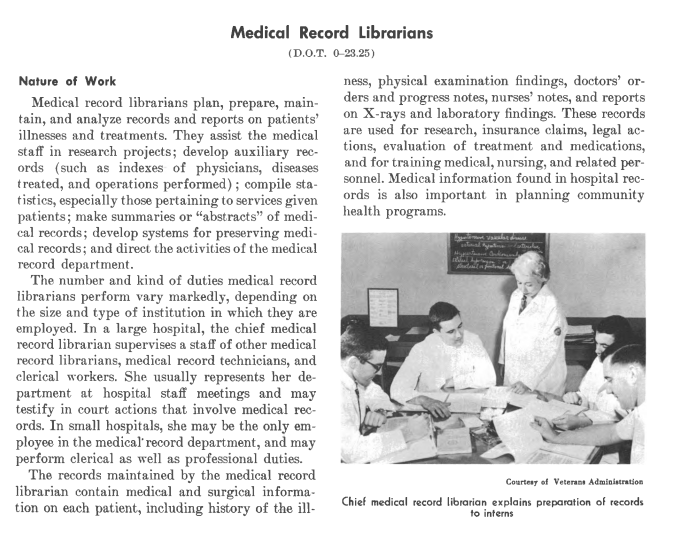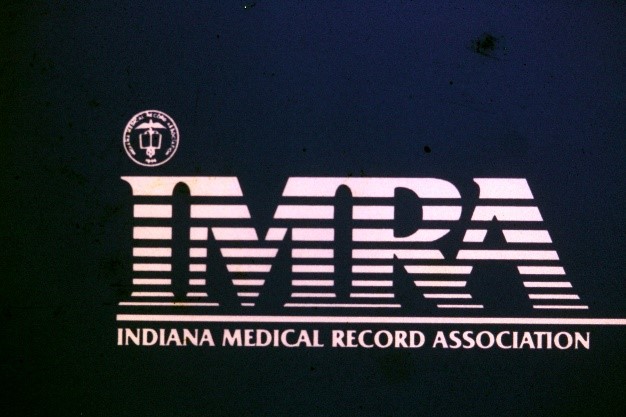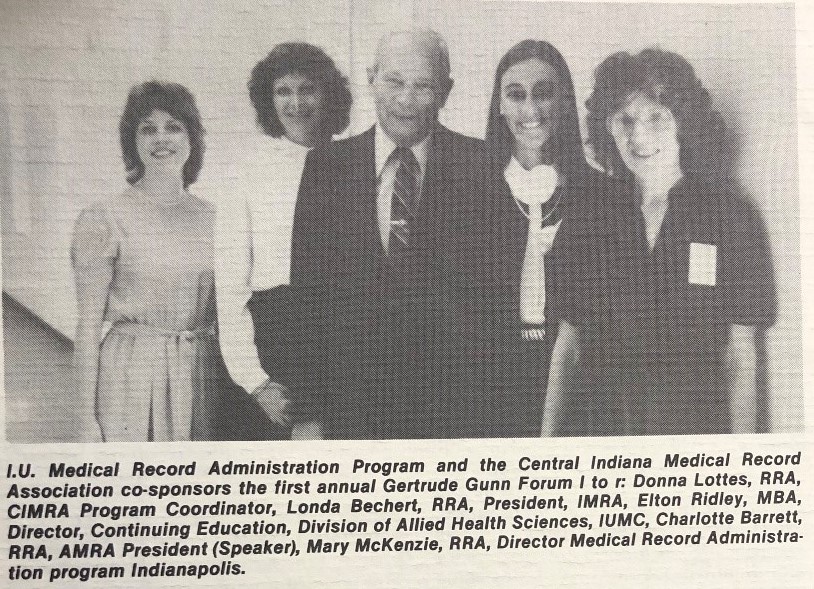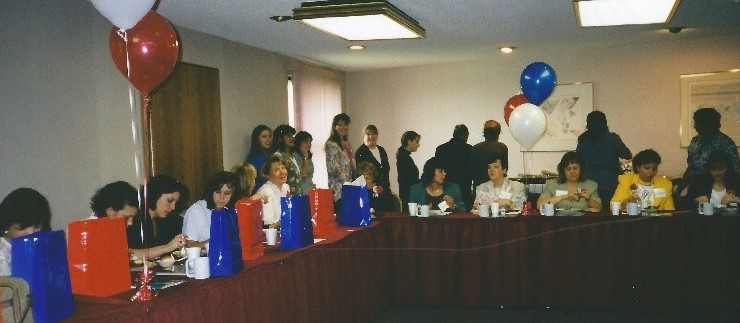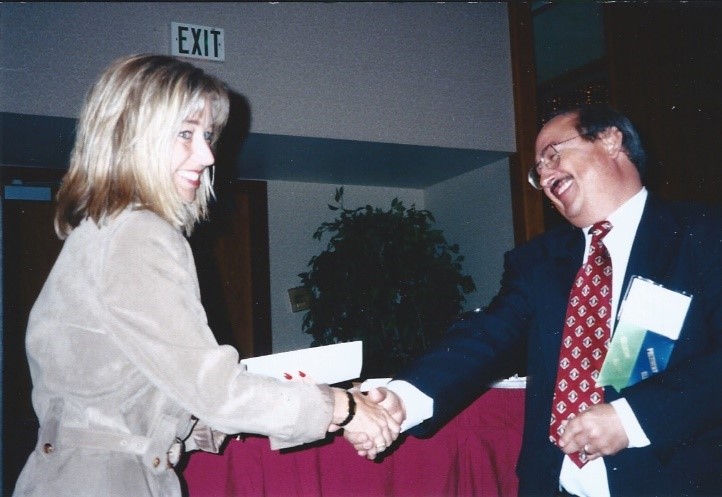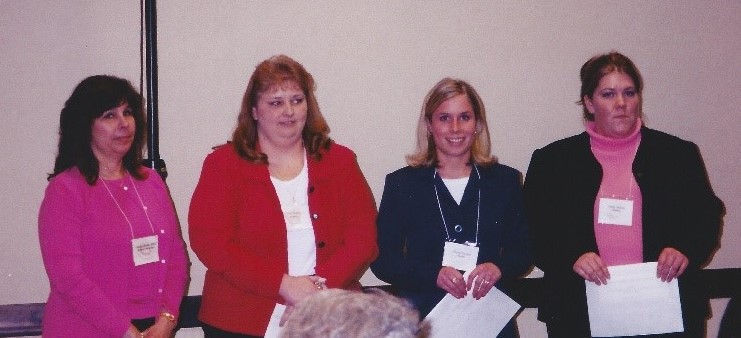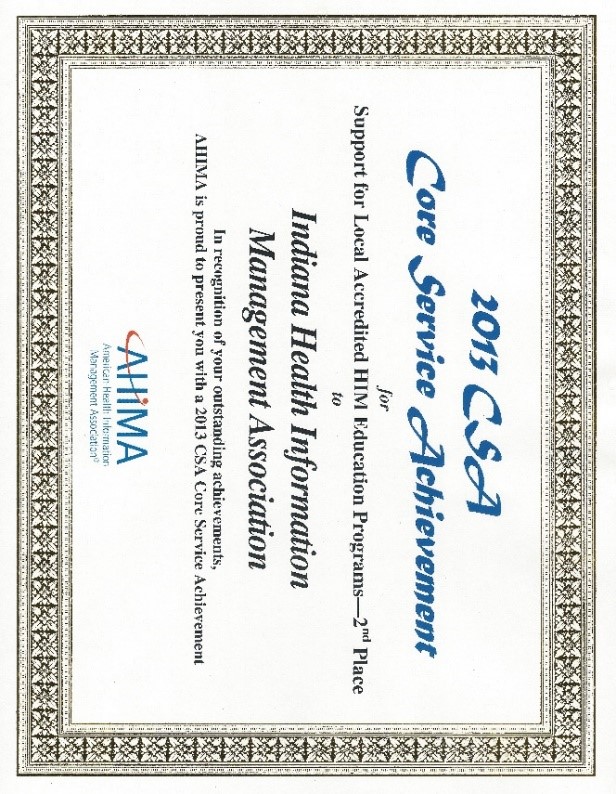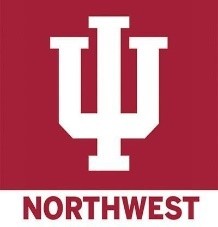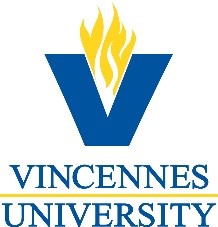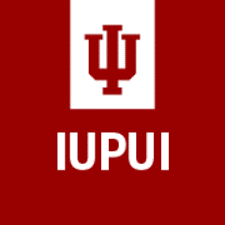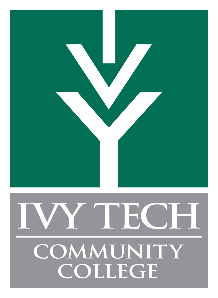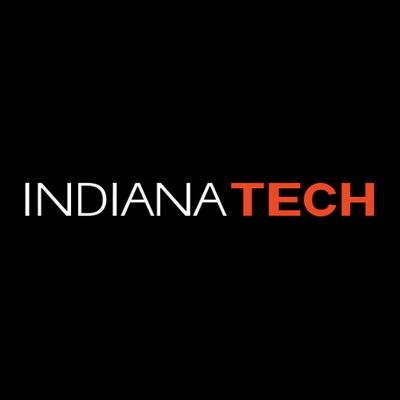Health Information Management in Indiana – Remembering Our LegacyOur beginning… Our legacy began in 1928 with the founding of the Association of Record Librarians of North America (ARLNA). As the 1930s began, ARLNA grew to 251 members. Active and associate members paid an initial $2 entrance fee to join and $3 a year for membership. In 1932, ARLNA decided to register “properly trained librarians” and appointed a registrar and three association members to examine credentials, create exams, and approve candidates. Before the creation of the registry, trained librarians were not required to take an exam. After the creation of the registry, hospitals that provided training to record librarians were required to submit the course curricula to the Association to ensure the curricula corresponded with its educational goals. Record librarians who took the ‘Examination for Registration’ paid $1.50. In 1933, ARLNA began registering medical record librarians as a Registered Record Librarian (RRL). In 1934, Edna K. Huffman, RRL, an Indiana member, became the seventh president of ARLNA. Ms. Huffman was also the author of Manual for Medical Record Librarians, the authoritative text on medical records during that time. In 1941, the first edition of Edna Huffman’s Manual for Medical Record Librarians was published. The 1940s were a dynamic time for Indiana. By the time Norma Bauman, RRL, became the 21st president in 1948, ARLNA had changed its name to the American Association of Medical Record Librarians (AAMRL). Ms. Bauman was the Medical Record Librarian at Methodist Hospital, Indianapolis. Ms. Bauman, although not considered an educator in the literal sense, had trained many young women who were active members of the Association. She was well known for her work with the Indiana Health Department, and for promoting education on a state level in the area of medical records. In 1948, the Indiana Association of Medical Record Librarians (IAMRL) was approved as an affiliate of the AAMRL and Martha Niewoehner, RRL, became the first president of IAMRL. Ms. Niewoehner was the Medical Record Librarian at Reid Memorial Hospital, Richmond, IN. The 1950s brought new beginnings to Indiana. Gertrude Gunn, RRL, was the IAMRL President from 1949 to 1951. Ms. Gunn completed a two-year presidency term. During her presidency, the Medical Records Program was established at Indiana University (IU) and was approved by the Council on Medical Education of the American Medical Association (AMA) in December 1950. The IU program was the first state university Medical Records Program in the United States. The program granted a Bachelor of Science (B.S.) degree in Medical Record Librarianship. Ms. Gunn was the Medical Records Program Director at IU Indianapolis. Also, in 1950, Indiana was represented at the national Association as Edna Huffman was named editor of the Journal of the American Association of Medical Record Librarians. The first student graduated from the IU Medical Records Program in 1952. In June 1952, The Indianapolis News published an article, “Medical Librarian Career Is New One”. The article told the story of the first graduate of the Indiana University medical record library science course and highlighted the opportunities of a new Medical Librarian career. The 1960s brought major changes to the medical record field. “As opportunities continued to grow for the promising profession of “medical record librarian” in the 1960s, the healthcare industry was undergoing significant changes. Medicare and Medicaid (and a corresponding new load of paperwork) were established when President Lyndon B. Johnson signed the Social Security Amendments, which amended the Social Security Act, in 1965. Computers also made their way into hospitals in this era, bringing with them all the promise and challenge inherent with new technology.” —From “Employment Outlook for Medical Technologists, Medical X-Ray Technicians, Medical Record Librarians, Occupational Outlook Report Series,” reprinted from the 1963-1964 Occupational Outlook Handbook, US Department of Labor Following a vote in 1969 that reflected overwhelming support for a name change, the national Association changed its name to the American Medical Record Association (AMRA), and Indiana changed its name to the Indiana Medical Record Association (IMRA). Members felt the new name more accurately represented the association and their work. The name became official on January 1, 1970. The 1970s brought change that reflected the evolution of the profession. Around 1970, the Indiana University Northwest Medical Record Technology (MRT) Program started taking shape. Before this, the MRT Program was based at St. Margaret Hospital in Hammond, IN. Students took classes and spent time in the Medical Record Department to apply their knowledge. No general education classes were included. In 1971, the first IU Northwest MRT class was accepted and graduated in spring 1973. At the time, students were at St. Margaret Hospital for the “medical record” courses and at Indiana University Northwest, Division of General and Technical Studies, East Chicago campus, taking general education courses. The Medical Record Technology Program was approved for accreditation in 1971 by the AMA’s Council on Medical Education. This approval allowed graduating students to be eligible to take the national credentialing exam to become an Accredited Record Technician (ART). During that time, the MRT Program was in a building behind the hospital that also housed the Radiography two-year program, Medical Lab Sciences two-year program, and the Respiratory Therapy two-year program. During the second accreditation survey in 1976, it was recommended that all four programs be transferred to the campus of IU Northwest in Gary, IN and become University based and Hospital affiliated. This began the Medical Record Technology Program located at IU Northwest in Gary. Dorinda Sattler, MJ, RHIA, CHPS is the current Associate of Science (A.S.) Health Information Technology Program Director at IU Northwest. Ms. Sattler is the fourth program director since the inception of the program. As Program Director, she follows Sarah Lasbury, RRL (1970 – 1973), JoAnne Bruce, RRL (1973 – 1977), and Margaret Skurka, MS, RHIA, CCS, FAHIMA (1977 – 2017). In 1973, continuing education became a hot topic at the National Association meetings. Members thought there was a need for new knowledge to meet the challenges of change and innovation in the profession. The continuing education topic was debated and was approved by the House of Delegates. In 1975, continuing education requirements were first established for ARTs and RRLs. In 1978, the Registered Record Administrator (RRA) credential replaced the RRL credential. The 1980s emphasized the importance of qualified medical record professionals. The 1980s will be remembered as when the prospective payment systems (PPS) and diagnosis related groups (DRGs) gave many medical record departments their first computers. The advent of DRGs was considered an opportunity for the Association’s members to display their skills and capability to improve data quality. The PPS, and DRGs, affected how members worked, the technology they used, and above all emphasized the importance of qualified medical records professionals. With the demand for qualified medical record professionals increasing, Indiana gained another Health Information Technology program. In August 1983, the Medical Records Technician (MRT) Program started at Vincennes University. The first graduating class was in May 1985 with 7 students graduating. The program was accredited by AMA’s Council for Allied Health Education Accreditation (CAHEA) in June 1986. The MRT program started as a face-to-face program. In the late 1990s, the program transitioned to online in addition to having classes on campus. Since the beginning of the program, it has continued to run strong both face-to-face and online. Janet Thomas, MS, RHIT, CCS, is the current A.S. Health Information Management Program Director at Vincennes University. Ms. Thomas is the fourth program director since the inception of the program. As Program Director, she follows Justin Rousse (1983 – 1984), Darrell King, MS, RHIA (1984 – 2001), and Sherry O’Neill, MS, RHIA (2001 – 2014). The 1990s brought a focus on technology and the advent of HIPAA. In 1991, AMRA released the position statement “Computer-Based Patient Record: An Essential Technology for Healthcare.” The statement was created in response to an Institute of Medicine study to improve the medical record. AMRA supported the idea of a computer-based record and confirmed its position by taking active leadership in creating the Computer-based Patient Record Institute (CPRI). “AMRA believes that a computer-based patient record is essential to quality care in today’s environment, is necessary to meet the needs of a growing number of users, and is possible to achieve in this decade.” Also, in 1991, the national Association changed its name from AMRA to what we know today, the American Health Information Management Association (AHIMA). This change also meant a name change to the Indiana Association – IMRA changed to the Indiana Health Information Management Association (IHIMA). On June 13, 1992, AHIMA held its first Certified Coding Specialist (CCS) examination. The examination was taken by 3,677 candidates, and 1,684 passed and earned the right to use the CCS credential. The first Certified Coding Specialist - Physician-based (CCS-P) credentials was granted in 1997. In 1996, U.S. Congress passes the Health Insurance Portability and Accountability Act (HIPAA). In 1999, the House of Delegates voted in support of new certification titles for all Registered Record Administrators (RRAs) and Accredited Record Technicians (ARTs). The 21st century saw an interest in the HIM field at an all-time high. On January 1, 2000, the Registered Health Information Technician (RHIT) credential replaced the Accredited Record Technician (ART) credential that was established back in 1953; the Registered Health Information Administrator (RHIA) credential replaced the RRA credential. In 2001, the Certified Coding Associate (CCA) entry-level coding credential was established. Although the Health Insurance Portability and Accountability Act (HIPAA) passed in 1996, HIPAA was the buzzword for the early years of the 21st century. Members found themselves the point persons for their organizations on the transactions, privacy, and security standards. A new credential, Certified in Healthcare Privacy (CHP), was introduced in 2002, as well as the Certified in Healthcare Security (CHS) and Certified in Healthcare Privacy and Security (CHPS) credentials, cosponsored with HIMSS, to showcase HIM professionals’ expertise. With HIPAA’s additional responsibilities came new opportunities for those who became privacy or security officers at their organizations: “HIM professionals have effectively managed the release of information in healthcare organizations for decades. Establishing policy, training staff, developing consents, releasing information, and documenting information use are key elements of the HIM role." In 2003, field testing of ICD-10-CM medical code sets were conducted by AHIMA, in conjunction with the American Hospital Association (AHA). Also, in 2003, AHIMA’s leadership recognized the need to create an independent accrediting organization for HIM educational programs, creating the Commission on Accreditation for Health Informatics and Information Management (CAHIIM) in 2006. Interest in implementing the Computer-Based Patient Record continued and in 2003 the term electronic health record (EHR) was adopted to describe this concept. In his 2004 State of the Union Address, President George W. Bush called for computerized health records – the beginning of the EHR revolution. With the increased technology, qualified health information professionals were in demand. Indiana gained a new Health Information Technology program. In August 2006, the Ivy Tech Community College, Indianapolis, Health Information Technology (HIT) program was just beginning. The program was accredited in November 2008 by CAHIIM and the first graduate of the program attained her RHIT in 2009. Classes were on campus until 2019 when the program transitioned to a hybrid format, a combination of online and face-to-face classes. The program has consistently stayed strong with enrollment between 15 – 20 students each year. Sarah Sallee, RHIA, is the current A.S. Health Information Technology Program Director at Ivy Tech Community College, Indianapolis. Ms. Sallee is the second program director since the start of the program; she follows Brenda Kupecky, MS, RHIA (2006 – 2017). The decade closed with enrollments in HIM programs, and interest in HIM careers, at an all-time high. The Commission on Certification for Health Informatics and Information Management (CCHIIM) (formerly the AHIMA Council on Certification) was created by AHIMA, as a standing commission of AHIMA, to assure the competencies of professionals practicing Health Informatics and Information Management (HIIM). CCHIIM provides strategic oversight of all AHIMA certification programs. The 2010’s highlighted how healthcare was rapidly transforming. The 2010’s will be remembered as having an increased focus on value-based care and a drive to improve patient outcomes. Interoperability, data-sharing, and access to healthcare information continued to be a critical requirement and health information exchanges continued to grow. With healthcare rapidly transforming, Indiana educational programs were created to meet the increased interest in HIM careers. In response to industry demand, CCHIIM developed the Certified Documentation Improvement Practitioner (CDIP) credential in 2011. While informal clinical documentation improvement (CDI) programs had been in acute care facilities since DRGs started, official CDI programs started to be identified as a distinct hospital department and profession in the mid-2000s. An increased use of documentation and coding for quality measurements and reimbursement programs across healthcare caused non-acute care facilities to also adopt CDI programs. The CDIP credential was created to support quality documentation and the integrity of the patient’s health record. January 2012, the Health Information Technology (HIT) program at Ivy Tech Community College, Fort Wayne, began and the program achieved CAHIIM approval in November 2014. The program began as a face-to-face program but transitioned to a fully online program in 2017. The program has awarded 44 associate degrees and 29 students have earned RHIT credentials as of February 2019. Heather Copen, RHIA, CCS-P, is the current A.S. Health Information Technology Program Director at the Ivy Tech Community College, Fort Wayne campus. Ms. Copen is the second program director since the inception of the program; she follows Reisha Wheeler, RHIA (2012 – 2013). July 2012, Indiana Tech in Fort Wayne began offering an online associates degree in Health Information Technology. The HIT program achieved CAHIIM approval in October 2015. Upon achieving this approval, there were already 311 students pursuing the degree. The HIT Program is an accelerated format that allows full-time students to complete an associate degree in 16 months. Indiana Tech also has an online Bachelor of Science Health Information Management program. The HIM Program is in Candidacy Status, pending accreditation review by CAHIIM. Bonnie Wilkins, MS, RHIA, is the HIT and HIM Program Director at Indiana Tech, Fort Wayne. In 2012, the Health Information Administration (HIA) program at Indiana University Northwest returned. IU Northwest established an HIA program in 1993, with the first graduates in 1995, but the school decided to close the program after this short period of time. The program was re-established in 2012 and was awarded full CAHIIM accreditation in November 2014. IU Northwest’s HIA program was built as a 2+2 program. Once students receive their A.S. in HIT, students transition to fully online courses to complete the B.S. degree. Most IU Northwest students’ progress from the A.S. to B.S. degree. Several HIM professionals have taken advantage of IU Northwest’s 2+2 program to return to complete their B.S. degree. Transfer students from other accredited HIT programs are starting to complete their B.S. degree at IU Northwest too. Linda Galocy, MS, RHIA, FAHIMA, is the B.S. Health Information Administration Program Director at IU Northwest. On October 1, 2015, the transition to ICD-10-CM/PCS medical code sets finally took effect. This routine administrative update became a highly charged political issue where Congressional hearings were held with demands for Congressional action to stop ICD-10. In the end, it took 20 years and three delays before ICD-10 was implemented. Meanwhile, AHIMA stayed at the forefront as the healthcare industry made the transition to ICD-10. In January 2019, the Master of Health Informatics Program at Indiana University, Indianapolis, was accredited by CAHIIM and the Health Informatics Accreditation Council. The IU Health Informatics (HI) Program is one of seven accredited programs of this type in the United States. Graduates of this program are eligible to sit for their credentialing exam by the American Medical Informatics Association (AMIA) and earn the AMIA Health Informatics Certification (AHIC) credential. The IU HI Master’s Program opens the door to HIM students wanting to earn a master’s degree in five years rather than six. Students can take graduate courses their senior year and those courses are applied to the master’s program. The IU HI Master’s Program is offered online or face-to-face. Josette Jones, PhD, RN is the current IU Master of Health Informatics Program Director. The IU Indianapolis HIM Program recently celebrated 70 years of education. Over the past 70 years there have been seven program directors. Lisa DesNoyers, MPH, RHIA, SME, is the current HIM Program Director (2015 – Present). She follows Gertrude Gunn, RRL (1950 – 1966), Mary McKenzie, RRA (1967 – 1995), Jan Ashton, RRA (1996 – 2000), Danita Forgey, MIS, RHIA, CCS, CCS-P (2000 – 2008), Felisa Tennant, MIS, RHIA, CHPS, CCS (2009 – 2011), and Lauri Perry, MJ, RHIA (2012 – 2015). Conclusion The HIM profession is continuously changing. Technological advances have changed the way HIM professionals work, but our focus has remained the same - on confidential, effective, efficient, trustworthy, and secure management of health information. The foundation of the HIM profession has not changed with time - to manage the information that makes up a patient’s health record. HIM in Indiana - Historical Timeline: Indiana’s National Accomplishments, Association Name Changes, AHIMA Credentials, Indiana HIT/HIM Programs, and Indiana HIT/HIM Program Directors as AHIMA/IHIMA President
Photo Timeline:
References: “About the Commission.” AHIMA. http://www.ahima.org/certification/cchiim. Accessed 29 March 2020. AHIMA. "75th Anniversary Series – ARLNA in the 1930's." Journal of AHIMA, vol. 74, no.2, February 2003, pp. 58-61. AHIMA. "75th Anniversary Series – An Association Marches Onward." Journal of AHIMA, vol. 74, no.3, March 2003, pp. 48-51. AHIMA. "75th Anniversary Series – The 1970s’s." Journal of AHIMA, vol. 74, no.5, July-August 2003, pp. 60-63. AHIMA. "75th Anniversary Series – The 1990s: Visions of the Future." Journal of AHIMA, vol. 74, no. 10, October 2003, pp. 50-53. “AHIMA Timeline (Name Changes, Credentials Awarded).” AHIMA. http://bok.ahima.org/doc?oid=57706#.XmFGA6hKjIV. Accessed 7 March 2020. Bair, Matt. “Indiana Tech Program Receives Accreditation.” Kosciusko County's Digital Daily Newspaper, 5 November 2015, http://www.inkfreenews.com/2015/11/05/indiana-tech-program-receives-accreditation/. Brooks, Ashley. “Health Information Management History: Past, Present & Future.” Rasmussen College, LLC. 23 March 2015. https://www.rasmussen.edu/degrees/health-sciences/blog/health-information-management-history/. Accessed 28 March 2020. Copen, Heather. “Re: State Professional Association (IHIMA) Research - Ivy Tech (Ft Wayne).” Email received 21 February 2019. DesNoyers, Lisa. “RE: IU Master's Degree Program in Health Informatics.” Email received 23 March 2020. Galocy, Linda. “RE: History of the HIT program at IUN.” Email received 10 April 2020. "Health Policy Brief: Updated Transitioning to ICD-10." Health Affairs. https://www.healthaffairs.org/do/10.1377/hpb20140403.830190/full/. Accessed 28 March 2020. “History of CAHIIM.” CAHIIM. https://www.cahiim.org/about-us/history. Accessed 7 March 2020. Indiana Death Certificate Index 1899-2011, Ancestry Library Edition, online www.ancestrylibrary.com, Death certificate for Martha Elise Niewoehner downloaded 24 March 2020. Indiana University. “Medical Records.” Bulletin of the Division of Allied Health Sciences, vol. LXII, no. 12, 30 May 1964, pp. 22-23. “International Classification of Diseases, (ICD-10-CM/PCS) Transition - Background.” Centers for Disease Control and Prevention, National Center for Health Statistics. 6 November 2015. www.cdc.gov/nchs/icd/icd10cm_pcs_background.htm. Kloss, Linda L. "Feet Firmly in the 21st Century: Reviewing A Decade of Expanding Vision, Influence, and Growth." Journal of AHIMA, vol. 81, no. 2, February 2010, pp. 20-23. Kupecky, Brenda. “Re: Question about Ivy Tech Community College Indpls.” Email received 22 March 2020. Lasbury, Sarah. “IHIMA article.” Email received 12 May 2020. Lewis, Carol A. “Fifty Years as a Health Information Management Professional: An American Perspective.” Health Information Management Journal, vol. 37, no. 2, June 2008, pp. 47–55. “Medical Librarian Career Is New One.” The Indianapolis News [Indianapolis, IN], 2 June 1953. p. 20. Melton, Magen. “Re: Vincennes University - HIM Program History.” Email received 10 March 2020. “Pen Portraits of Past Presidents.” AHIMA. http://bok.ahima.org/doc?oid=301507#.XmBIx6hKjIV. Accessed 7 March 2020. Sallee, Sarah Marie. “Re: History of the HIT program at Ivy Tech Indpls.” Email received 24 March 2020. Skurka, Margaret. “Re: History of the HIT program at IUN.” Email received 11 March 2020. “The History of Heath Information Management – From Then to Now.” OpenText Corp. https://blogs.opentext.com/history-heath-information-management-now/. Accessed 29 March 2020. Thomas, Janet. “Re: Vincennes University - HIM Program History.” Email received 24 March 2020.
Prepared by: Acknowledgements: |
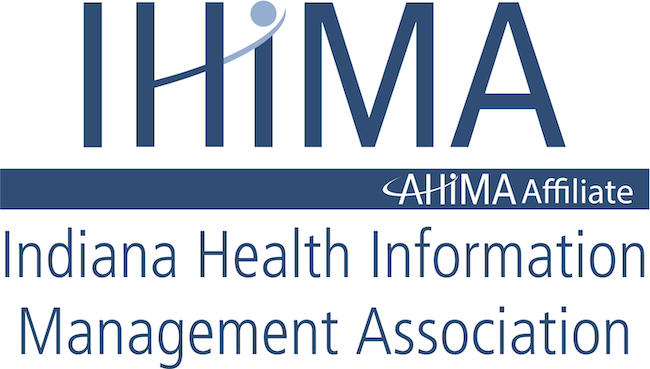
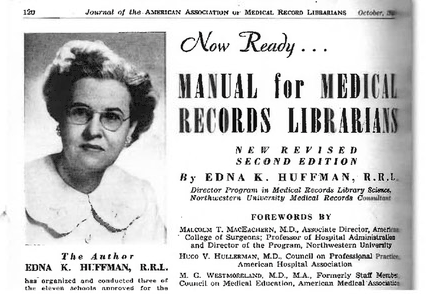
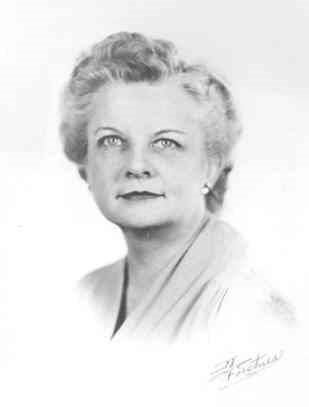 Gertrude L. Gunn, RRL, 1948. Ms. Gunn was IAMRL’s President, 1949-1951. She was also the Medical Records Program Director at IU Indianapolis from 1950 until she retired in 1966.
Gertrude L. Gunn, RRL, 1948. Ms. Gunn was IAMRL’s President, 1949-1951. She was also the Medical Records Program Director at IU Indianapolis from 1950 until she retired in 1966. 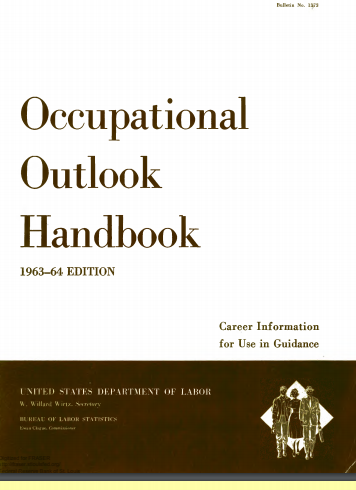 "Employment Outlook for Medical Technologists, Medical X-Ray Technicians, Medical Record Librarians, Occupational Outlook Report Series,” reprinted from the 1963-1964 Occupational Outlook Handbook, US Department of Labor
"Employment Outlook for Medical Technologists, Medical X-Ray Technicians, Medical Record Librarians, Occupational Outlook Report Series,” reprinted from the 1963-1964 Occupational Outlook Handbook, US Department of Labor